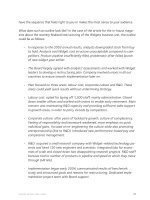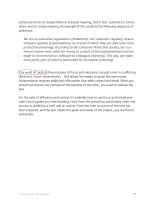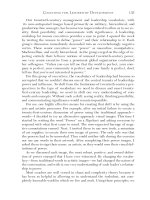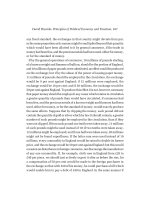THE ECONOMIC CONSEQUENCES OF THE PEACE phần 6 potx
Bạn đang xem bản rút gọn của tài liệu. Xem và tải ngay bản đầy đủ của tài liệu tại đây (35.95 KB, 13 trang )
THE ECONOMIC CONSEQUENCES OF THE PEACE
Get any book for free on: www.Abika.com
66
I feel much more confidence in the approximate accuracy of
the total figure(32*) than in its division between the different
claimants. The reader will observe that in any case the addition
of pensions and allowances enormously increases the aggregate
claim, raising it indeed by nearly double. Adding this figure to
the estimate under other heads, we have a total claim against
Germany of £8,000 million.(33*) I believe that this figure is
fully high enough, and that the actual result may fall somewhat
short of it.(34*) In the next section of this chapter the
relation of this figure to Germany's capacity to pay will be
examined. It is only necessary here to remind the reader of
certain other particulars of the treaty which speak for
themselves:
(1) Out of the total amount of the claim, whatever it
eventually turns out to be, a sum of £1,000 million must be paid
before 1 May 1921. The possibility of this will be discussed
below. But the treaty itself provides certain abatements. In the
first place, this sum is to include the expenses of the armies of
occupation since the armistice (a large charge of the order of
magnitude of £200 million which under another article of the
treaty no. 249 is laid upon Germany).(35*) But further,
'such supplies of food and raw materials as may be judged by the
governments of the Principal Allied and Associated Powers to be
essential to enable Germany to meet her obligations for
reparation may also, with the approval of the said governments,
be paid for out of the above sum.'(36*) This is a qualification
of high importance. The clause, as it is drafted, allows the
finance ministers of the Allied countries to hold out to their
electorates the hope of substantial payments at an early date,
while at the same time it gives to the reparation commission a
discretion, which the force of facts will compel them to
exercise, to give back to Germany what is required for the
maintenance of her economic existence. This discretionary power
renders the demand for an immediate payment of £1,000 million
less injurious than it would otherwise be, but nevertheless it
does not render it innocuous. In the first place, my conclusions
in the next section of this chapter indicate that this sum cannot
be found within the period indicated, even if a large proportion
is in practice returned to Germany for the purpose of enabling
her to pay for imports. In the second place, the reparation
commission can only exercise its discretionary power effectively
by taking charge of the entire foreign trade of Germany, together
with the foreign exchange arising out of it, which will be quite
beyond the capacity of any such body. If the reparation
commission makes any serious attempt to administer the collection
of this sum of £1,000 million, and to authorise the return to
Germany of a part of it, the trade of Central Europe will be
strangled by bureaucratic regulation in its most inefficient
form.
(2) In addition to the early payment in cash or kind of a sum
of £1,000 million, Germany is required to deliver bearer bonds to
a further amount of £2,000 million or, in the event of the
payments in cash or kind before 1 May 1921, available for
reparation, falling short of £1,000 million by reason of the
permitted deductions, to such further amount as shall bring the
total payments by Germany in cash, kind, and bearer bonds up to 1
THE ECONOMIC CONSEQUENCES OF THE PEACE
Get any book for free on: www.Abika.com
67
May 1921, to a figure of £3,000 million altogether.(37*) These
bearer bonds carry interest at 2 1/2% per annum from 1921 to
1925, and at 5% plus 1% for amortisation thereafter. Assuming,
therefore, that Germany is not able to provide any appreciable
surplus towards reparation before 1921, she will have to find a
sum of £75 million annually from 1921 to 1925, and £180 million
annually thereafter.(38*)
(3) As soon as the reparation commission is satisfied that
Germany can do better than this, 5% bearer bonds are to be issued
for a further £2,000 million, the rate of amortisation being
determined by the commission hereafter. This would bring the
annual payment to £28O million without allowing anything for the
discharge of the capital of the last £2,000 million.
(4) Germany's liability, however, is not limited to £5,000
million, and the reparation commission is to demand further
instalments of bearer bonds until the total enemy liability under
annex I has been provided for. On the basis of my estimate of
£8,000 million for the total liability, which is more likely to
be criticised as being too low than as being too high, the amount
of this balance will be £3,000 million. Assuming interest at 5%,
this will raise the annual payment to £430 million. without
allowance for amortisation.
(5) But even this is not all. There is a further provision of
devastating significance. Bonds representing payments in excess
of £3,000 million are not to be issued until the commission is
satisfied that Germany can meet the interest on them. But this
does not mean that interest is remitted in the meantime. As from
1 May 1921, interest is to be debited to Germany on such part of
her outstanding debt as has not been covered by payment in cash
or kind or by the issue of bonds as above,(39*) and 'the rate of
interest shall be 5 per cent unless the commission shall
determine at some future time that circumstances justify a
variation of this rate.' That is to say, the capital sum of
indebtedness is rolling up all the time at compound interest. The
effect of this provision towards increasing the burden is, on the
assumption that Germany cannot pay very large sums at first,
enormous. At 5% compound interest a capital sum doubles itself in
fifteen years. On the assumption that Germany cannot pay more
than £150 million annually until 1936 (i.e. 5% interest on £3,000
million) the £5,000 million on which interest is deferred will
have risen to £10,000 million, carrying an annual interest charge
of £500 million. That is to say, even if Germany pays £150
million annually up to 1936, she will nevertheless owe us at that
date more than half as much again as she does now (£13,000
million as compared with £8,000 million). From 1936 onwards she
will have to pay to us £650 million annually in order to keep
pace with the interest alone. At the end of any year in which she
pays less than this sum she will owe more than she did at the
beginning of it. And if she is to discharge the capital sum in
thirty years from 1936, i.e. in forty-eight years from the
armistice, she must pay an additional £130 million annually,
making £780 million in all.(40*)
It is, in my judgment, as certain as anything can be, for
reasons which I will elaborate in a moment, that Germany cannot
pay anything approaching this sum. Until the treaty is altered,
therefore, Germany has in effect engaged herself to hand over to
the Allies the whole of her surplus production in perpetuity.
THE ECONOMIC CONSEQUENCES OF THE PEACE
Get any book for free on: www.Abika.com
68
(6) This is not less the case because the reparation
commission has been given discretionary powers to vary the rate
of interest, and to postpone and even to cancel the capital
indebtedness. In the first place, some of these powers can only
be exercised if the commission or the governments represented on
it are unanimous.(41*) But also, which is perhaps more important,
it will be the duty of the reparation commission, until there has
been a unanimous and far-reaching change of the policy which the
treaty represents, to extract from Germany year after year the
maximum sum obtainable. There is a great difference between
fixing a definite sum, which though large is within Germany's
capacity to pay and yet to retain a little for herself, and
fixing a sum far beyond her capacity, which is then to be reduced
at the discretion of a foreign commission acting with the object
of obtaining each year the maximum which the circumstances of
that year permit. The first still leaves her with some slight
incentive for enterprise, energy, and hope. The latter skins her
alive year by year in perpetuity, and however skilfully and
discreetly the operation is performed, with whatever regard for
not killing the patient in the process, it would represent a
policy which, if it were really entertained and deliberately
practised, the judgment of men would soon pronounce to be one of
the most outrageous acts of a cruel victor in civilised history.
There are other functions and powers of high significance
which the treaty accords to the reparation commission. But these
will be most conveniently dealt with in a separate section.
III. GERMANY'S CAPACITY TO PAY
The forms in which Germany can discharge the sum which she
has engaged herself to pay are three in number
(1) immediately transferable wealth in the form of gold,
ships, and foreign securities; (2) the value of property in ceded
territory, or surrendered under the armistice; (3) annual
payments spread over a term of years, partly in cash and partly
in materials such as coal products, potash, and dyes.
There is excluded from the above the actual restitution of
property removed from territory occupied by the enemy, as, for
example, Russian gold, Belgian and French securities, cattle,
machinery, and works of art. In so far as the actual goods taken
can be identified and restored, they must clearly be returned to
their rightful owners, and cannot be brought into the general
reparation pool. This is expressly provided for in article 238 of
the treaty.
1. Immediately transferable wealth
(a) Gold. After deduction of the gold to be returned to
Russia, the official holding of gold as shown in the Reichsbank's
return of 30 November 1918 amounted to £115,417,900. This was a
very much larger amount than had appeared in the Reichsbank's
return prior to the war,(42*) and was the result of the vigorous
campaign carried on in Germany during the war for the surrender
to the Reichsbank not only of gold coin but of gold ornaments of
every kind. Private hoards doubtless still exist but, in view of
the great efforts already made, it is unlikely that either the
German government or the Allies will be able to unearth them. The
THE ECONOMIC CONSEQUENCES OF THE PEACE
Get any book for free on: www.Abika.com
69
return can therefore be taken as probably representing the
maximum amount which the German government are able to extract
from their people. In addition to gold there was in the
Reichsbank a sum of about £1 million in silver. There must be,
however, a further substantial amount in circulation, for the
holdings of the Reichsbank were as high as £9.1 million on 31
December 1917, and stood at about £6 million up to the latter
part of October 1918, when the internal run began on currency of
every kind.(43*) We may, therefore, take a total of (say) £125
million for gold and silver together at the date of the
armistice.
These reserves, however, are no longer intact. During the
long period which elapsed between the armistice and the peace it
became necessary for the Allies to facilitate the provisioning of
Germany from abroad. The political condition of Germany at that
time and the serious menace of Spartacism rendered this step
necessary in the interests of the Allies themselves if they
desired the continuance in Germany of a stable government to
treat with. The question of how such provisions were to be paid
for presented, however, the gravest difficulties. A series of
conferences was held at Trèves, at Spa, at Brussels, and
subsequently at Château Villette and Versailles, between
representatives of the Allies and of Germany, with the object of
finding some method of payment as little injurious as possible to
the future prospects of reparation payments. The German
representatives maintained from the outset that the financial
exhaustion of their country was for the time being so complete
that a temporary loan from the Allies was the only possible
expedient. This the Allies could hardly admit at a time when they
were preparing demands for the immediate payment by Germany of
immeasurably larger sums. But, apart from this, the German claim
could not be accepted as strictly accurate so long as their gold
was still untapped and their remaining foreign securities
unmarketed. In any case, it was out of the question to suppose
that in the spring of 1919 public opinion in the Allied countries
or in America would have allowed the grant of a substantial loan
to Germany. On the other hand, the Allies were naturally
reluctant to exhaust on the provisioning of Germany the gold
which seemed to afford one of the few obvious and certain sources
for reparation. Much time was expended in the exploration of all
possible alternatives. but it was evident at last that, even if
German exports and saleable foreign securities had been available
to a sufficient value, they could not be liquidated in time, and
that the financial exhaustion of Germany was so complete that
nothing whatever was immediately available in substantial amounts
except the gold in the Reichsbank. Accordingly a sum exceeding
£50 million in all out of the Reichsbank gold was transferred by
Germany to the Allies (chiefly to the United States, Great
Britain, however, also receiving a substantial sum) during the
first six months of 1919 in payment for foodstuffs.
But this was not all. Although Germany agreed, under the
first extension of the armistice, not to export gold without
Allied permission, this permission could not be always withheld.
There were liabilities of the Reichsbank accruing in the
neighbouring neutral countries, which could not be met otherwise
than in gold. The failure of the Reichsbank to meet its
liabilities would have caused a depreciation of the exchange so
THE ECONOMIC CONSEQUENCES OF THE PEACE
Get any book for free on: www.Abika.com
70
injurious to Germany's credit as to react on the future prospects
of reparation. In some cases, therefore, permission to export
gold was accorded to the Reichsbank by the Supreme Economic
Council of the Allies.
The net result of these various measures was to reduce the
gold reserve of the Reichsbank by more than half, the figures
falling from £115 million to £55 million in September 1919.
It would be possible under the treaty to take the whole of
this latter sum for reparation purposes. It amounts, however, as
it is, to less than 4 % of the Reichsbank's note issue, and the
psychological effect of its total confiscation might be expected
(having regard to the very large volume of mark-notes held
abroad) to destroy the exchange value of the mark almost
entirely. A sum of £5 million, £10 million, or even £20 million
might be taken for a special purpose. But we may assume that the
reparation commission will judge it imprudent, having regard to
the reaction on their future prospects of securing payment, to
ruin the German currency system altogether, more particularly
because the French and Belgian governments, being holders of a
very large volume of mark-notes formerly circulating in the
occupied or ceded territory have a great interest in maintaining
some exchange value for the mark, quite apart from reparation
prospects.
It follows, therefore, that no sum worth speaking of can be
expected in the form of gold or silver towards the initial
payment of £1,000 million due by 1921.
(b) Shipping. Germany has engaged, as we have seen above, to
surrender to the Allies virtually the whole of her merchant
shipping. A considerable part of it, indeed, was already in the
hands of the Allies prior to the conclusion of peace, either by
detention in their ports or by the provisional transfer of
tonnage under the Brussels agreement in connection with the
supply of foodstuffs.(44*) Estimating the tonnage of German
shipping to be taken over under the treaty at 4 million gross
tons, and the average value per ton at £30 per ton, the total
money value involved is £120 million.(45*)
(c) Foreign securities. Prior to the census of foreign
securities carried out by the German government in September
1916,(46*) of which the exact results have not been made public,
no official return of such investments was ever called for in
Germany, and the various unofficial estimates are confessedly
based on insufficient data, such as the admission of foreign
securities to the German stock exchanges, the receipts of the
stamp duties, consular reports, etc. The principal German
estimates current before the war are given in the appended
footnote.(47*) This shows a general consensus of opinion among
German authorities that their net foreign investments were
upwards of £1,250 million. I take this figure as the basis of my
calculations, although I believe it to be an exaggeration; £1,000
million would probably be a safer figure.
Deductions from this aggregate total have to be made under
four heads.
(i) Investments in Allied countries and in the United States,
which between them constitute a considerable part of the world,
have been sequestrated by Public Trustees, custodians of enemy
property, and similar officials, and are not available for
reparation except in so far as they show a surplus over various
THE ECONOMIC CONSEQUENCES OF THE PEACE
Get any book for free on: www.Abika.com
71
private claims. Under the scheme for dealing with enemy debts
outlined in chapter 4, the first charge on these assets is the
private claims of Allied against German nationals. It is
unlikely, except in the United States, that there will be any
appreciable surplus for any other purpose.
(ii) Germany's most important fields of foreign investment
before the war were not, like ours, overseas, but in Russia,
Austria-Hungary, Turkey, Roumania, and Bulgaria. A great part of
these has now become almost valueless, at any rate for the time
being; especially those in Russia and Austria-Hungary. If present
market value is to be taken as the test, none of these
investments are now saleable above a nominal figure. Unless the
Allies are prepared to take over these securities much above
their nominal market valuation, and hold them for future
realisation, there is no substantial source of funds for
immediate payment in the form of investments in these countries.
(iii) While Germany was not in a position to realise her
foreign investments during the war to the degree that we were,
she did so nevertheless in the case of certain countries and to
the extent that she was able. Before the United States came into
the war, she is believed to have resold a large part of the pick
of her investments in American securities, although some current
estimates of these sales (a figure of £60 million has been
mentioned) are probably exaggerated. But throughout the war and
particularly in its later stages, when her exchanges were weak
and her credit in the neighbouring neutral countries was becoming
very low, she was disposing of such securities as Holland,
Switzerland, and Scandinavia would buy or would accept as
collateral. It is reasonably certain that by June 1919 her
investments in these countries had been reduced to a negligible
figure and were far exceeded by her liabilities in them. Germany
has also sold certain overseas securities, such as Argentine
cedulas, for which a market could be found.
(iv) It is certain that since the armistice there has been a
great flight abroad of the foreign securities still remaining in
private hands. This is exceedingly difficult to prevent. German
foreign investments are as a rule in the form of bearer
securities and are not registered. They are easily smuggled
abroad across Germany's extensive land frontiers, and for some
months before the conclusion of peace it was certain that their
owners would not be allowed to retain them if the Allied
governments could discover any method of getting hold of them.
These factors combined to stimulate human ingenuity, and the
efforts both of the Allied and of the German governments to
interfere effectively with the outflow are believed to have been
largely futile.
In face of all these considerations, it will be a miracle if
much remains for reparation. The countries of the Allies and of
the United States, the countries of Germany's own allies, and the
neutral countries adjacent to Germany exhaust between them almost
the whole of the civilised world; and, as we have seen, we cannot
expect much to be available for reparation from investments in
any of these quarters. Indeed there remain no countries of
importance for investments except those of South America.
To convert the significance of these deductions into figures
involves much guesswork. I give the reader the best personal
estimate I can form after pondering the matter in the light of
THE ECONOMIC CONSEQUENCES OF THE PEACE
Get any book for free on: www.Abika.com
72
the available figures and other relevant data.
I put the deduction under (i) at £300 million, of which £100
million may be ultimately available after meeting private debts,
etc.
As regards (ii) according to a census taken by the
Austrian Ministry of Finance on 31 December 1912, the nominal
value of the Austro-Hungarian securities held by Germans was
£197,300,000. Germany's pre-war investments in Russia outside
government securities have been estimated at £95 million, which
is much lower than would be expected, and in 1906 Sartorius von
Waltershausen estimated her investments in Russian government
securities at £150 million. This gives a total of £245 million,
which is to some extent borne out by the figure of £200 million
given in 1911 by Dr Ischchanian as a deliberately modest
estimate. A Roumanian estimate, published at the time of that
country's entry into the war, gave the value of Germany's
investments in Roumania at £4,000,000-£4,400,000, of which
£2,800,000-£3,200,000 were in government securities. An
association for the defence of French interests in Turkey, as
reported in the Temps (8 September 1919), has estimated the total
amount of German capital invested in Turkey at about £59 million,
of which, according to the latest Report of the council of
foreign bondholders, £32,500,000 was held by German nationals in
the Turkish external debt. No estimates are available to me of
Germany's investments in Bulgaria. Altogether I venture a
deduction of £500 million in respect of this group of countries
as a whole.
Resales and the pledging as collateral of securities during
the war under (iii) I put at £100 million to £150 million,
comprising practically all Germany's holding of Scandinavian,
Dutch, and Swiss securities, a part of her South American
securities, and a substantial proportion of her North American
securities sold prior to the entry of the United States into the
war.
As to the proper deduction under (iv) there are naturally no
available figures. For months past the European Press has been
full of sensational stories of the expedients adopted. But if we
put the value of securities which have already left Germany or
have been safely secreted within Germany itself beyond discovery
by the most inquisitorial and powerful methods at £100 million,
we are not likely to overstate it.
These various items lead, therefore, in all to a deduction of
a round figure of about £1,000 million, and leave us with an
amount of £250 million theoretically still available.(48*)
To some readers this figure may seem low, but let them
remember that it purports to represent the remnant of saleable
securities upon which the German government might be able to lay
hands for public purposes. In my own opinion it is much too high,
and considering the problem by a different method of attack I
arrive at a lower figure. For leaving out of account sequestered
Allied securities and investments in Austria, Russia, etc., what
blocks of securities, specified by countries and enterprises, can
Germany possibly still have which could amount to as much as £250
million? I cannot answer the question. She has some Chinese
government securities which have not been sequestered, a few
Japanese perhaps, and a more substantial value of first-class
South American properties. But there are very few enterprises of
THE ECONOMIC CONSEQUENCES OF THE PEACE
Get any book for free on: www.Abika.com
73
this class still in German hands, and even their value is
measured by one or two tens of millions, not by fifties or
hundreds. He would be a rash man, in my judgment, who joined a
syndicate to pay £100 million in cash for the unsequestered
remnant of Germany's overseas investments. If the reparation
commission is to realise even this lower figure, it is probable
that they will have to nurse, for some years, the assets which
they take over, not attempting their disposal at the present
time.
We have, therefore, a figure of from £100 million to £250
million as the maximum contribution from Germany's foreign
securities.
Her immediately transferable wealth is composed, then, of:
(a) gold and silver say £60 million; (b) ships £120
million; (c) foreign securities £100-250 million.
Of the gold and silver, it is not, in fact, practicable to
take any substantial part without consequences to the German
currency system injurious to the interests of the Allies
themselves. The contribution from all these sources together
which the reparation commission can hope to secure by May 1921
may be put, therefore, at from £250 million to £350 million as a
maximum.(49*)
2. Property in ceded territory or surrendered under the armistace
As the treaty has been drafted Germany will not receive
important credits available towards meeting reparation in respect
of her property in ceded territory.
Private property in most of the ceded territory is utilised
towards discharging private German debts to Allied nationals, and
only the surplus, if any, is available towards reparation. The
value of such property in Poland and the other new states is
payable direct to the owners.
Government property in Alsace-Lorraine, in territory ceded to
Belgium, and in Germany's former colonies transferred to a
mandatory, is to be forfeited without credit given. Buildings,
forests, and other state property which belonged to the former
kingdom of Poland are also to be surrendered without credit.
There remain, therefore, government properties, other than the
above, surrendered to Poland, government properties in Schleswig
surrendered to Denmark,(50*) the value of the Saar coalfields,
the value of certain river craft, etc., to be surrendered under
the ports, waterways, and railways chapter, and the value of the
German submarine cables transferred under annex VII of the
reparation chapter.
Whatever the treaty may say, the reparation commission will
not secure any cash payments from Poland. I believe that the Saar
coalfields have been valued at from £15 million to £20 million. A
round figure of £30 million for all the above items, excluding
any surplus available in respect of private property, is probably
a liberal estimate.
There remains the value of material surrendered under the
armistice. Article 250 provides that a credit shall be assessed
by the reparation commission for rolling-stock surrendered under
the armistice as well as for certain other specified items, and
generally for any material so surrendered for which the
reparation commission think that credit should be given, 'as
THE ECONOMIC CONSEQUENCES OF THE PEACE
Get any book for free on: www.Abika.com
74
having non-military value'. The rolling-stock (150,000 wagons and
5,000 locomotives) is the only very valuable item. A round figure
of £50 million, for all the armistice surrenders, is probably
again a liberal estimate.
We have, therefore, £80 million to add in respect of this
heading to our figure of £250-350 million under the previous
heading. This figure differs from the preceding in that it does
not represent cash capable of benefiting the financial situation
of the Allies, but is only a book credit between themselves or
between them and Germany.
The total of £330 million to £430 million now reached is not,
however, available for reparation. The first charge upon it,
under article 251 of the treaty, is the cost of the armies of
occupation both during the armistice and after the conclusion of
peace. The aggregate of this figure up to May 1921 cannot be
calculated until the rate of withdrawal is known which is to
reduce the monthly cost from the figure exceeding £20 million
which prevailed during the first part of 1919, to that of £1
million, which is to be the normal figure eventually. I estimate,
however, that this aggregate may be about £200 million. This
leaves us with from £100 million to £200 million still in hand.
Out of this, and out of exports of goods, and payments in
kind under the treaty prior to May 1921 (for which I have not as
yet made any allowance), the Allies have held out the hope that
they will allow Germany to receive back such sums for the
purchase of necessary food and raw materials as the former deem
it essential for her to have. It is not possible at the present
time to form an accurate judgment either as to the money-value of
the goods which Germany will require to purchase from abroad in
order to re-establish her economic life, or as to the degree of
liberality with which the Allies will exercise their discretion.
If her stocks of raw materials and food were to be restored to
anything approaching their normal level by May 1921, Germany
would probably require foreign purchasing power of from £100 to
£200 million at least, in addition to the value of her current
exports. While this is not likely to be permitted, I venture to
assert as a matter beyond reasonable dispute that the social and
economic condition of Germany cannot possibly permit a surplus of
exports over imports during the period prior to May 1921, and
that the value of any payments in kind with which she may be able
to furnish the Allies under the treaty in the form of coal, dyes,
timber, or other materials will have to be returned to her to
enable her to pay for imports essential to her existence.(51*)
The reparation commission can, therefore, expect no addition
from other sources to the sum of from £100 million to £200
million with which we have hypothetically credited it after the
realisation of Germany's immediately transferable wealth, the
calculation of the credits due to Germany under the treaty, and
the discharge of the cost of the armies of occupation. As Belgium
has secured a private agreement with France, the United States,
and Great Britain, outside the treaty, by which she is to
receive, towards satisfaction of her claims, the first £100
million available for reparation, the upshot of the whole matter
is that Belgium may possibly get her £100 million by May 1921,
but none of the other Allies are likely to secure by that date
any contribution worth speaking of. At any rate, it would be very
imprudent for finance ministers to lay their plans on any other
THE ECONOMIC CONSEQUENCES OF THE PEACE
Get any book for free on: www.Abika.com
75
hypothesis.
3. Annual payments spread over a term of years
It is evident that Germany's pre-war capacity to pay an
annual foreign tribute has not been unaffected by the almost
total loss of her colonies, her overseas connections, her
mercantile marine, and her foreign properties, by the cession of
ten per cent of her territory and population, of one-third of her
coal and of three-quarters of her iron ore, by two million
casualties amongst men in the prime of life, by the starvation of
her people for four years, by the burden of a vast war debt, by
the depreciation of her currency to less than one-seventh its
former value, by the disruption of her allies and their
territories, by revolution at home and Bolshevism on her borders,
and by all the unmeasured ruin in strength and hope of four years
of all-swallowing war and final defeat.
All this, one would have supposed, is evident. Yet most
estimates of a great indemnity from Germany depend on the
assumption that she is in a position to conduct in the future a
vastly greater trade than ever she has had in the past.
For the purpose of arriving at a figure it is of no great
consequence whether payment takes the form of cash (or rather of
foreign exchange) or is partly effected in kind (coal, dyes,
timber, etc.), as contemplated by the treaty. In any event, it is
only by the export of specific commodities that Germany can pay,
and the method of turning the value of these exports to account
for reparation purposes is, comparatively, a matter of detail.
We shall lose ourselves in mere hypothesis unless we return
in some degree to first principles and, whenever we can, to such
statistics as there are. It is certain that an annual payment can
only be made by Germany over a series of years by diminishing her
imports and increasing her exports, thus enlarging the balance in
her favour which is available for effecting payments abroad.
Germany can pay in the long run in goods, and in goods only,
whether these goods are furnished direct to the Allies, or
whether they are sold to neutrals and the neutral credits so
arising are then made over to the Allies. The most solid basis
for estimating the extent to which this 'process can be carried
is to be found, therefore, in an analysis of her trade returns
before the war. Only on the basis of such an analysis,
supplemented by some general data as to the aggregate
wealth-producing capacity of the country, can a rational guess be
made as to the maximum degree to which the exports of Germany
could be brought to exceed her imports.
In the year 1913 Germany's imports amounted to £538 million
and her exports to £505 million, exclusive of transit trade and
bullion. That is to say, imports exceeded exports by about £33
million. On the average of the five years ending 1913, however,
her imports exceeded her exports by a substantially larger
amount, namely, £74 million. It follows, therefore, that more
than the whole of Germany's pre-war balance for new foreign
investment was derived from the interest on her existing foreign
securities, and from the profits of her shipping, foreign
banking, etc. As her foreign properties and her mercantile marine
are now to be taken from her, and as her foreign banking and
other miscellaneous sources of revenue from abroad have been
THE ECONOMIC CONSEQUENCES OF THE PEACE
Get any book for free on: www.Abika.com
76
largely destroyed, it appears that, on the pre-war basis of
exports and imports, Germany, so far from having a surplus
wherewith to make a foreign payment, would be not nearly
self-supporting. Her first task, therefore, must be to effect a
readjustment of consumption and production to cover this deficit.
Any further economy she can effect in the use of imported
commodities, and any further stimulation of exports will then be
available for reparation.
Two-thirds of Germany's import and export trade is enumerated
under separate headings in the following tables. The
considerations applying to the enumerated portions may be assumed
to apply more or less to the remaining one-third, which is
composed of commodities of minor importance individually.
German exports, 1913 Amount Percentage of
(million £) total exports
Iron goods (including
tin-plates, etc.) 66.13 13.2
Machinery and parts
(including motor-cars) 37.55 7.5
Coal, coke, and briquettes 35.34 7.0
Woollen goods (including
raw and combined wool
and clothing) 29.40 5.9
Cotton goods (including
raw cotton, yarn and thread) 28.15 5.6
196.57 39.2
Cereals, etc. (including
rye, oats, wheat, hops) 21.18 4.1
Leather and leather goods 15.47 3.0
Sugar 13.20 2.6
Paper, etc. 13.10 2.6
Furs 11.75 2.2
Electrical goods
(installations, machinery,
lamps, cables) 10.88 2.2
Silk goods 10.10 2.0
Dyes 9.76 1.9
Copper goods 6.50 1.3
Toys 5.15 1.0
Rubber and rubber goods 4.27 0.9
Books, maps, and music 3.71 0.8
Potash 3.18 0.6
Glass 3.14 0.6
Potassium chloride 2.91 0.6
Pianos, organs, and parts 2.77 0.6
Raw zinc 2.74 0.5
Porcelain 2.53 0.5
142.34 28.0
Other goods, unenumerated 165.92 32.8
THE ECONOMIC CONSEQUENCES OF THE PEACE
Get any book for free on: www.Abika.com
77
Total 504.83 100.0
German imports, 1913 Amount Percentage of
(million £) total imports
1. Raw materials:
Cotton 30.35 5.6
Hides and skins 24.86 4.6
Wool 23.67 4.4
Copper 16.75 3.1
Coal 13.66 2.5
Timber 11.60 2.2
Iron ore 11.35 2.1
Furs 9.35 1.7
Flax and flaxseed 9.33 1.7
Saltpetre 8.55 1.6
Silk 7.90 1.5
Rubber 7.30 1.4
Jute 4.70 0.9
Petroleum 3.49 0.7
Tin 2.91 0.5
Phosphorus chalk 2.32 0.4
Lubricating oil 2.29 0.4
190.38 35.3
II. Food, tobacco, etc.:
Cereals, etc. (wheat,
barley, bran, rice, maize,
oats, rye, clover) 65.51 12.2
Oilseeds and cake, etc.
(including palm kernels,
copra, cocoa beans) 20.53 3.8
Cattle, lamb fat, bladders 14.62 2.8
Coffee 10.95 2.0
Eggs 9.70 1.8
Tobacco 6.70 1.2
Butter 5.93 1.1
Horses 5.81 1.1
Fruit 3.65 0.7
Fish 2.99 0.6
Poultry 2.80 0.5
Wine 2.67 0.5
151.86 28.3
III. Manufactures:
Cotton yarn and thread
and cotton goods 9.41 1.8
Woollen yarn and
woollen goods 7.57 1.4
Machinery 4.02 0.7
THE ECONOMIC CONSEQUENCES OF THE PEACE
Get any book for free on: www.Abika.com
78
21.00 3.9
IV. Unenumerated 175.28 32.5
Total 538.52 100.0
These tables show that the most important exports consisted
of: (1) iron goods, including tin-plates (13.2%); (2) machinery,
etc. (7.5%); (3) coal, coke, and briquettes (7%); (4) woollen
goods, including raw and combed wool (5.9 %); and (5) cotton
goods, including cotton yarn and thread and raw cotton (5.6%),
these five classes between them accounting for 39.2% of the total
exports. It will be observed that all these goods are of a kind
in which before the war competition between Germany and the
United Kingdom was very severe. If, therefore, the volume of such
exports to overseas or European destinations is very largely
increased the effect upon British export trade must be
correspondingly serious. As regards two of the categories,
namely, cotton and woollen goods, the increase of an export trade
is dependent upon an increase of the import of the raw material,
since Germany produces no cotton and practically no wool. These
trades are therefore incapable of expansion unless Germany is
given facilities for securing these raw materials (which can only
be at the expense of the Allies) in excess of the pre-war
standard of consumption, and even then the effective increase is
not the gross value of the exports, but only the difference
between the value of the manufactured exports and of the imported
raw material. As regards the other three categories, namely,
machinery, iron goods, and coal, Germany's capacity to increase
her exports will have been taken from her by the cessions of
territory in Poland, Upper Silesia, and Alsace-Lorraine. As has
been pointed out already, these districts accounted for nearly
one-third of Germany's production of coal. But they also supplied
no less than three-quarters of her iron-ore production, 38% of
her blast furnaces, and 9.5% of her iron and steel foundries.
Unless, therefore, Alsace-Lorraine and Upper Silesia send their
iron ore to Germany proper, to be worked up, which will involve
an increase in the imports for which she will have to find
payment, so far from any increase in export trade being possible,
a decrease is inevitable.(52*)
Next on the list come cereals, leather goods, sugar, paper,
furs, electrical goods, silk goods, and dyes. Cereals are not a
net export and are far more than balanced by imports of the same
commodities. As regards sugar, nearly 90 per cent of Germany's
pre-war exports came to the United Kingdom.(53*) An increase in
this trade might be stimulated by the grant of a preference in
this country to German sugar or by an arrangement by which sugar
was taken in part payment for the indemnity on the same lines as
has been proposed for coal, dyes, etc. Paper exports also might
be capable of some increase. Leather goods, furs, and silks
depend upon corresponding imports on the other side of the
account. Silk goods are largely in competition with the trade of
France and Italy. The remaining items are individually very
small. I have heard it suggested that the indemnity might be paid
to a great extent in potash and the like. But potash before the
war represented 0.6% of Germany's export trade, and about £3
million in aggregate value. Besides, France, having secured a









